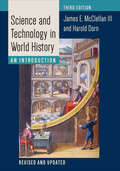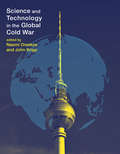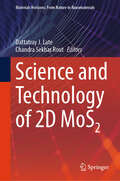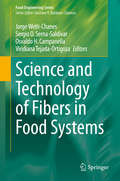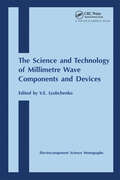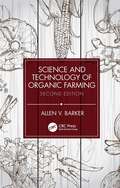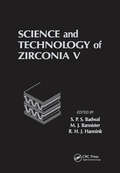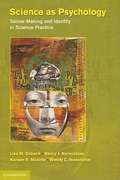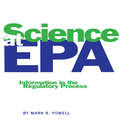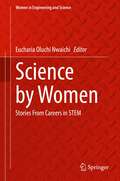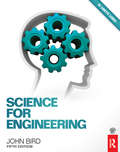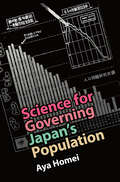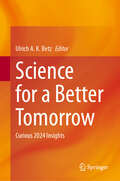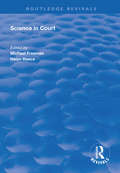- Table View
- List View
Science and Technology in World History: An Introduction
by Harold Dorn James E. McClellan IIIArguably the best general history of science and technology ever published.Tracing the relationship between science and technology from the dawn of civilization to the early twenty-first century, James E. McClellan III and Harold Dorn’s bestselling book argues that technology as "applied science" emerged relatively recently, as industry and governments began funding scientific research that would lead directly to new or improved technologies.McClellan and Dorn identify two great scientific traditions: the useful sciences, which societies patronized from time immemorial, and the exploration of questions about nature itself, which the ancient Greeks originated. The authors examine scientific traditions that took root in China, India, and Central and South America, as well as in a series of Near Eastern empires in late antiquity and the Middle Ages. From this comparative perspective, McClellan and Dorn survey the rise of the West, the Scientific Revolution of the seventeenth century, the Industrial Revolution, and the modern marriage of science and technology. They trace the development of world science and technology today while raising provocative questions about the sustainability of industrial civilization.This new edition of Science and Technology in World History offers an enlarged thematic introduction and significantly extends its treatment of industrial civilization and the technological supersystem built on the modern electrical grid. The Internet and social media receive increased attention. Facts and figures have been thoroughly updated and the work includes a comprehensive Guide to Resources, incorporating the major published literature along with a vetted list of websites and Internet resources for students and lay readers.
Science and Technology in the Global Cold War (Transformations: Studies in the History of Science and Technology)
by John Krige Naomi OreskesInvestigations of how the global Cold War shaped national scientific and technological practices in fields from biomedicine to rocket science.The Cold War period saw a dramatic expansion of state-funded science and technology research. Government and military patronage shaped Cold War technoscientific practices, imposing methods that were project oriented, team based, and subject to national-security restrictions. These changes affected not just the arms race and the space race but also research in agriculture, biomedicine, computer science, ecology, meteorology, and other fields. This volume examines science and technology in the context of the Cold War, considering whether the new institutions and institutional arrangements that emerged globally constrained technoscientific inquiry or offered greater opportunities for it.The contributors find that whatever the particular science, and whatever the political system in which that science was operating, the knowledge that was produced bore some relation to the goals of the nation-state. These goals varied from nation to nation; weapons research was emphasized in the United States and the Soviet Union, for example, but in France and China scientific independence and self-reliance dominated. The contributors also consider to what extent the changes to science and technology practices in this era were produced by the specific politics, anxieties, and aspirations of the Cold War.ContributorsElena Aronova, Erik M. Conway, Angela N. H. Creager, David Kaiser, John Krige, Naomi Oreskes, George Reisch, Sigrid Schmalzer, Sonja D. Schmid, Matthew Shindell, Asif A. Siddiqi, Zuoyue Wang, Benjamin Wilson
Science and Technology of 2D MoS2 (Materials Horizons: From Nature to Nanomaterials)
by Dattatray J. Late Chandra Sekhar RoutThis book provides a comprehensive overview of the current state of the art in 2D MoS2 materials synthesis, properties, and mimics of various applications. It covers a brief history of MoS2, its origin, properties, and applications in various fields such as optoelectronics, nanoelectronics, catalysis, energy storage and generation, nano-lubricants, etc. The book focuses on novel synthesis approaches of bulk and nano-MoS2. It includes various innovative characterization techniques, different approaches to surface functionalization, strengths, and limitations of these materials along with their different properties. Additionally, it addresses the enhancing the properties of the materials using heterostructure formation with other materials. The topics covered in the book are of vital importance in a wide range of modern and emerging layered materials employed in most industries, academics, healthcare, food, environment, and research institutes. The book brings together numerous experts in the field of MoS2 on novel synthesis, usual properties, and applications of this modern material to address fundamental issues prevailing in this thematic domain. This book is recommended for physics, Chemistry, materials science and engineering departments and as a reference for researchers in the field.
Science and Technology of Aroma, Flavor, and Fragrance in Rice
by Deepak Kumar Verma Prem Prakash SrivastavWith contributions from a broad range of leading researchers, this book focuses on advances and innovations in rice aroma, flavor, and fragrance research. Science and Technology of Aroma, Flavor, and Fragrance in Rice is specially designed to present an abundance of recent research, advances, and innovations in this growing field. Aroma is one of the diagnostic aspects of rice quality that can determine acceptance or rejection of rice before it is tested. Aroma is also considered as an important property of rice that indicates its preferable high quality and price in the market. An assessment of known data reveals that more than 450 chemical compounds have been documented in various aromatic and non-aromatic rice cultivars. The primary goal of research is to identify the compounds responsible for the characteristic rice aroma. Many attempts have been made to search for the key compounds contributing to rice aroma, but any single compound or group of compounds could not reported that are fully responsible. There is no single analytical technique that can be used for investigation of volatile aroma compounds in rice samples although there are currently many technologies available for the extraction of rice volatile aroma compounds. These technologies have been modified from time to time according to need, and many of them are helping the emergence of a new form, particularly in the distillation, extraction, and quantification concept. This new volume helps to fill a void in the research by focusing solely on aroma, flavor, and fragrance of rice, helping to meet an important need in rice research and production. Key features of this volume: • provides an overview of aromatic rice from different countries • looks at traditional extraction methods for chemicals associated with rice aroma, flavor, and fragrance • presents new and modern approaches in extraction of rice aroma chemicals • explores genetic engineering for fragrance in rice
Science and Technology of Fibers in Food Systems (Food Engineering Series)
by Jorge Welti-Chanes Osvaldo H. Campanella Sergio O. Serna Saldívar Viridiana Tejada-OrtigozaThis text provides comprehensive coverage of fibers used in food formulations, starting with the understanding of their basic chemical structure and how they are present and organized in the cell wall structure, their physicochemical and functional properties, their impact on the digestive process and their role and preventive action against various chronic diseases including colon cancer. The book focuses on traditional and new fiber rich sources, incorporating an integrated approach in terms of the technological and engineering processes used to obtain and incorporate them in traditional foods, plus their characterization, extraction and modification. The study of processing conditions including the chemical, physical and enzymatic processes of fiber extraction and modification are also covered, including traditional and emerging processing technologies, plus the application of fibers in the development of new products and processes. Science and Technology of Fibers in Food Systems integrates knowledge of fibers from their basic structural and property aspects and the applications of these ingredients to extraction process analysis, modification and feasibility for use at the industry level. The chapters incorporate the physiological aspects related to the consumption of fiber for prevention of serious diseases.
Science and Technology of Integrated Ferroelectrics: Selected Papers from Eleven Years of the Proceedings of the International Symposium of Integrated Ferroelectronics
by Ramamoorthy Ramesh Carlos Pazde-Araujo George W TaylorThe aim of this book is to present in one volume some of the most significant developments that have taken place in the field of integrated ferroelectrics during the last decade of the twentieth century. The book begins with a comprehensive introduction to integrated ferroelectrics and follows with fifty-three papers selected by Carlos Paz de Arauj
Science and Technology of Interfaces, International Symposium in Honor of Dr. Bhakta Rath
by The Minerals Metals Materials SocietyThese proceedings of the 2002 TMS Annual Meeting present contemporary research and developments on interfaces in various materials ranging from advanced nanostructured materials to high Tc superconductors. Attention is given to the effect of interfaces on the properties of advanced materials.
Science and Technology of Millimetre Wave Components and Devices
by V. E. LyubchenkoIn this comprehensive book, all aspects of Millimeter Waves (MMWs) are explored with an emphasis on the fundamental aspects of the associated physical phenomena. Each chapter provides a review of the main aspects of the subject, including: fundamental limitations and prospects of semiconductor device application in MMW radio systems; multi-element
Science and Technology of Organic Farming
by Allen V. BarkerOrganic farming is not only a philosophy; it is also a well-researched science. The second edition of The Science and Technology of Organic Farming presents the scientific basis of organic farming and the methods of application needed to achieve adequate yields through plant nutrition and protection. Organic farming is a scientifically derived method of improving soil fertility to increase agricultural yields with limited chemical inputs. As such, it can meet public demand for reduced chemical inputs in agriculture and play a key role in meeting the needs of a growing world population. The new edition of this highly regarded book gives clear and comprehensive details on how soil fertility can be maintained and how plants can be nourished in organic agriculture. Chapters on soil fertility and plant nutrition explain the chemistry of the plant, the soil, and the soil solution and outline the importance of plant macronutrients and micronutrients. The book offers practical information on using of green manures, composts and lime to maintain soil fertility; introduces methods of tillage of land; provides organic methods of controlling weeds, insects, and diseases; and suggests how food produce can be stored without refrigeration. The text provides information on how to assess and govern the nutritional status of crops and the fertility and condition of soil and presents guidelines, recommendations, and procedures for determining the best fertility recommendations for individual situations. This edition includes an entirely new chapter on hydroponics that explains organic approaches to hydroponic crop production. With a full bibliography of references, this text is a practical guide for anyone interested in organic farming, from farmers and agricultural advisers to teachers, soil scientists, plant scientist, entomologists and students of other biological and environmental sciences.
Science and Technology of Separation Membranes 2 Vol Set
by Tadashi UragamiOffers a comprehensive overview of membrane science and technology from a single source Written by a renowned author with more than 40 years’ experience in membrane science and technology, and polymer science Covers all major current applications of membrane technology in two definitive volumes Includes academic analyses, applications and practical problems for each existing membrane technology Includes novel applications such as membrane reactors, hybrid systems and optical resolution as well as membrane fuel cells
Science and Technology of Zirconia V
by M., BannisterThis book is based on the Fifth International Conference that was held on 16-21 August, 1992 in Melbourne, Australia, in conjunction with AUSTCERAM 92. It demonstrates that the field of Zirconia ceramics remains one of scientific challenge and technical attraction.
Science and the State: From the Scientific Revolution to World War II (New Approaches to the History of Science and Medicine)
by John GascoigneWas it coincidence that the modern state and modern science arose at the same time? This overview of the relations of science and state from the Scientific Revolution to World War II explores this issue, synthesising a range of approaches from history and political theory. John Gascoigne argues the case for an ongoing mutual dependence of the state and science in ways which have promoted the consolidation of both. Drawing on a wide body of scholarship, he shows how the changing functions of the state have brought a wider engagement with science, while the possibilities that science make available have increased the authority of the state along with its prowess in war. At the end of World War II, the alliance between science and state was securely established and, Gascoigne argues, is still firmly embodied in the post-war world.
Science as Psychology
by Lisa M. Osbeck Nancy J. Nersessian Kareen R. Malone Wendy C. NewstetterScience as Psychology reveals the complexity and richness of rationality by demonstrating how social relationships, emotion, culture and identity, are implicated in the problem-solving practices of laboratory scientists. The authors gather and analyze interview and observational data from innovation-focused laboratories in the engineering sciences to show how the complex practices of laboratory research scientists provide rich psychological insights, and how a better understanding of science practice facilitates understanding of human beings more generally. The study focuses not on dismantling the rational core of scientific practice, but on illustrating how social, personal and cognitive processes are intricately woven together in scientific thinking. The authors argue that this characterization addresses the integration problem in science studies - how to characterize the fluid entanglements of cognitive, affective, material, cultural and other dimensions of discovery and problem solving. The book is thus a contribution to science studies, the psychology of science and general psychology.
Science at EPA: Information in the Regulatory Process
by Mark R. PowellThe U.S. Environmental Protection Agency was created to protect public health and the environment, and it has traditionally emphasized its regulatory mission over its scientific mission. Yet for environmental policy to be credible with the public and policymakers, EPA's actions must have a sound basis in science. In Science at EPA, Mark Powell offers detailed case studies that map the origins, flow, and impact of scientific information in eight EPA decisions involving the agency's major statutory programs. Drawing on extensive research and interviews, he provides the most comprehensive examination available on the acquisition and use of science in environmental regulation. Powell describes the key obstacles to the practical, efficient, and effective acquisition and use of knowledge in what is a crucial, but complex endeavor. His book is an essential contribution for practitioners, scholars and students, and citizens who are determined to protect our environment rationally and effectively.
Science at the Bar: Law, Science, and Technology in America (Twentieth Century Fund Books/Reports/Studies #9)
by Sheila JasanoffIssues spawned by the headlong pace of developments in science and technology fill the courts. How should we deal with frozen embryos and leaky implants, dangerous chemicals, DNA fingerprints, and genetically engineered animals? The realm of the law, to which beleaguered people look for answers, is sometimes at a loss--constrained by its own assumptions and practices, Sheila Jasanoff suggests. This book exposes American law's long-standing involvement in constructing, propagating, and perpetuating a variety of myths about science and technology. Science at the Bar is the first book to examine in detail how two powerful American institutions--both seekers after truth--interact with each other. Looking at cases involving product liability, medical malpractice, toxic torts, genetic engineering, and life and death, Jasanoff argues that the courts do not simply depend on scientific findings for guidance--they actually influence the production of science and technology at many different levels. Research is conducted and interpreted to answer legal questions. Experts are selected to be credible on the witness stand. Products are redesigned to reduce the risk of lawsuits. At the same time the courts emerge here as democratizing agents in disputes over the control and deployment of new technologies, advancing and sustaining a public dialogue about the limits of expertise. Jasanoff shows how positivistic views of science and the law often prevent courts from realizing their full potential as centers for a progressive critique of science and technology. With its lucid analysis of both scientific and legal modes of reasoning, and its recommendations for scholars and policymakers, this book will be an indispensable resource for anyone who hopes to understand the changing configurations of science, technology, and the law in our litigious society.
Science by Women: Stories From Careers in STEM (Women in Engineering and Science)
by Eucharia Oluchi NwaichiThis book provides a roadmap for those embarking on a career in STEM, whether in the research or industry realms. Focusing on paths taken by women, the contributors lend their stories, tips and tricks, and hardships they faced entering into fields historically dominated by men. The authors provide practical advice, highlighting soft skills that are not often taught as modules in the classroom. Topics include research collaborations, performance enhancement, the gender lens in research design and development, imposter syndrome felt by many women in science, ethics in science, scaling feminine leadership, being an influencer as a science leader, and time and resources optimization for career advancement in science from resource-poor settings. Others interested in science and its impacts on society will also find the book informative and timely. As an important part of the Organization for Women in Science in the Developing World (OWSD), University of Port Harcourt Branch Book project, the work hopes to inspire women and men, girls and boys to enter and apply themselves to secure the future in STEM.
Science for All Children: A Guide to Improving Elementary Science Education in Your School District
by National Academy of Sciences Staff Smithsonian Institution StaffRemember the first time you planted a seed and watched it sprout? Or explored how a magnet attracted a nail? If these questions bring back memories of joy and wonder, then you understand the idea behind inquiry-based science--an approach to science education that challenges children to ask questions, solve problems, and develop scientific skills as well as gain knowledge. Inquiry-based science is based on research and experience, both of which confirm that children learn science best when they engage in hands-on science activities rather than read from a textbook.The recent National Science Education Standards prepared by the National Research Council call for a revolution in science education. They stress that the science taught must be based on active inquiry and that science should become a core activity in every grade, starting in kindergarten. This easy-to-read and practical book shows how to bring about the changes recommended in the standards. It provides guidelines for planning and implementing an inquiry-based science program in any school district.The book is divided into three parts. "Building a Foundation for Change," presents a rationale for inquiry-based science and describes how teaching through inquiry supports the way children naturally learn. It concludes with basic guidelines for planning a program.School administrators, teachers, and parents will be especially interested in the second part, "The Nuts and Bolts of Change." This section describes the five building blocks of an elementary science program: Community and administrative support. A developmentally appropriate curriculum. Opportunities for professional development. Materials support. Appropriate assessment tools. Together, these five elements provide a working model of how to implement hands-on science.The third part, "Inquiry-Centered Science in Practice," presents profiles of the successful inquiry-based science programs in districts nationwide. These profiles show how the principles of hands-on science can be adapted to different school settings.If you want to improve the way science is taught in the elementary schools in your community, Science for All Children is an indispensable resource.
Science for Engineering, 5th ed
by John BirdA practical introduction to the engineering science required for engineering study and practice. Science for Engineering is an introductory textbook that assumes no prior background in engineering. This new edition covers the fundamental scientific knowledge that all trainee engineers must acquire in order to pass their exams, and has been brought fully in line with the compulsory science and mathematics units in the new engineering course specifications. John Bird focuses upon engineering examples, enabling students to develop a sound understanding of engineering systems in terms of the basic laws and principles. This book includes over 580 worked examples, 1300 further problems, 425 multiple choice questions (with answers), and contains sections covering the mathematics that students will require within their engineering studies, mechanical applications, electrical applications and engineering systems. Colour layout helps navigation and highlights key learning points, formulae and exercises Understanding can be tested with the 580 worked examples, 1300 further problems and 425 multiple choice questions contained within the book Focuses on real-world situations and examples in order to maximise relevance to the student reader This book is supported by a companion website of materials that can be found at www.routledge/cw/bird, this resource including fully worked solutions of all the further problems for students to access for the first time, and the full solutions and marking schemes for the revision tests found within the book for lecturers/instructors use. In addition, all 433 illustrations will be available for downloading by staff..
Science for Governing Japan's Population (Science in History)
by Aya HomeiTwenty-first-century Japan is known for the world's most aged population. Faced with this challenge, Japan has been a pioneer in using science to find ways of managing a declining birth rate. Science for Governing Japan's Population considers the question of why these population phenomena have been seen as problematic. What roles have population experts played in turning this demographic trend into a government concern? Aya Homei examines the medico-scientific fields around the notion of population that developed in Japan from the 1860s to the 1960s, analyzing the role of the population experts in the government's effort to manage its population. She argues that the formation of population sciences in modern Japan had a symbiotic relationship with the development of the neologism, 'population' (jinkō), and with the transformation of Japan into a modern sovereign power. Through this history, Homei unpacks assumptions about links between population, sovereignty, and science. This title is also available as Open Access.
Science for a Better Tomorrow: Curious 2024 Insights
by Ulrich A. K. BetzThis book explores the intersection of biosciences, artificial intelligence (AI), and information technology (IT), highlighting their potential to drive innovation in biomedicine and health, particularly in the context of pandemic resiliency and human longevity. The book expands on the discussion held at the Curious2024 – Future Insight Conference, capturing the innovative spirit and collaborative ethos of the conference. In this book, readers will find a diverse array of topics, including individualized medicine for cardiovascular disease, the sustainable transformation of chemical processes, and the future of drug discovery through an AI-driven lens. The book also investigates the role of synthetic biology in leveraging the ground truth of intelligence and explores the potential of developing conscious service robots. Chapters written by keynote speakers from the Curious2024 – Future Insight Conference emphasize the importance of interdisciplinary and transdisciplinary dialogue for breakthrough innovation. These contributions also provide a comprehensive analysis of the challenges and opportunities that lie ahead, making this book an essential read for those interested in the future of science and technology. By highlighting the crucial role of scientists in solving today's problems and enabling the dreams of a better tomorrow, the book appeals to a broad readership of researchers, scholars, and practitioners in biosciences, AI, and IT. It also serves as a valuable resource for early career researchers seeking mentorship and guidance.
Science in Court (Routledge Revivals)
by Michael Freeman Helen ReeceFirst published in 1998, this volume contains essays from leading thinkers on both sides of the Atlantic on the relationship between law and science. Science plays an ever-increasing part in the development of legislation and the adjudication of cases. Its limitations and its value are explored in these essays which discuss issues of methodology and of evidence. Amongst areas covered are silicone breast implants, the rape trauma syndrome, the environment, inventions and Bayesianism.
Science in Design: Solidifying Design with Science and Technology (Textile Institute Professional Publications)
by Tarun Grover Mugdha TharejaThere is an important overlap between science and design. The most significant technological developments cannot be produced without designers to conceptualize them. By the same token, designers cannot do their job properly without a good understanding of the scientific or technical principles that are being developed within the product. Science in Design: Solidifying Design with Science and Technology reveals the significance of the essential yet understudied intersection of design and scientific academic research and encompasses technological development, scientific principles, and the point of overlap between science and design. Encourages readers to comprehend the role of science in all facets of design Discusses the fundamental involvement of science required for engineering and design irrespective of whether the design is from an individual, business, or social perspective Covers the ontology, characteristics, and application of science in major fields of design education and design research, with an introduction of emerging practices transforming sustainable growth through applied behavioral models Depicts the art and science of material selection using new design techniques and technology advances like augmented reality, AI, and decision-support toolkits This unique book will benefit scientists, technologists, and engineers, as well as designers and professionals, across a variety of industries dealing with scientific analysis of design research methodology, design lifecycle, and problem solving.
Science in Early Childhood
by Coral Campbell Wendy Jobling Coral Campbell Wendy Jobling Christine HowittScience education in the early years is vital in assisting young children to come to know about and understand the world around them. Science in Early Childhood Education covers the theoretical underpinnings and practical applications of teaching science in early childhood settings in way that is engaging and accessible. It is a comprehensive resource for students, as well as early childhood teachers and carers, and provides up-to-date coverage of the Early Years Learning Framework. This text explores the current issues and debates in early childhood science education from an Australian perspective, whilst recognizing the links to international practice and research. A summary at the start of each chapter helps students identify the key themes and ideas in early science education, and application boxes throughout the text illustrate how theories relate to practice. Written by the experts in the field, Science in Early Childhood Education is essential reading for pre-service teachers.
Science in Early Childhood
by Coral Campbell Wendy JoblingScience education in the early years is vital in assisting young children to come to know about and understand the world around them. Science in Early Childhood covers the theoretical underpinnings and practical applications of teaching science in early childhood settings in way that is engaging and accessible. It is a comprehensive resource for students, as well as early childhood teachers and carers and provides up-to-date coverage of the Early Years Learning Framework. This text explores the current issues and debates in early childhood science education from an Australian perspective, whilst recognising the links to international practice and research. A summary at the start of each chapter helps students identify the key themes and ideas in early science education and application boxes throughout the text illustrate how theories relate to practice. Written by experts in the field, Science in Early Childhood is essential reading for pre-service teachers.
Science in Environmental Policy: The Politics of Objective Advice
by Ann Campbell KellerScientists often bring issues to the policy agenda, translating scientific questions into everyday language and political terms. When Roger Revelle characterized Earth as a spaceship in testimony to Congress in 1957, his evocative language framed the issue of our planet's climate vulnerability in a way that technical discourse could not. In this book, Ann Campbell Keller examines the influence of scientists on environmental policymaking and makes the novel argument that scientists' adherence to the role of neutral advisor varies over the course of the policymaking process. Keller divides the policy process into three stages--agenda setting, legislation, and implementation--and compares scientists' influence on acid rain and climate change policy at these different stages over the course of several decades. She finds that scientists face more pressure to uphold the ideal of objectivity as policy-making processes advance and become more formalized, and thus are more likely to engage in advocacy and persuasion in the earlier, less formal, agenda-setting stage of the process. In the later, more structured legislative and implementation phases, scientists--working hard to give the appearance of neutral expertise--cede the role of persuader to others. Keller draws on theoretical work in political science and science studies and on empirical evidence from scientific reports, news coverage, congressional hearings, and interviews. Focusing on comparable cases and considering scientists' participation in them over time, she offers unique insights into how the context of decision making affects scientists' policy influence and emphasizes the multiple pathways by which scientific meaning is constructed in public settings.
